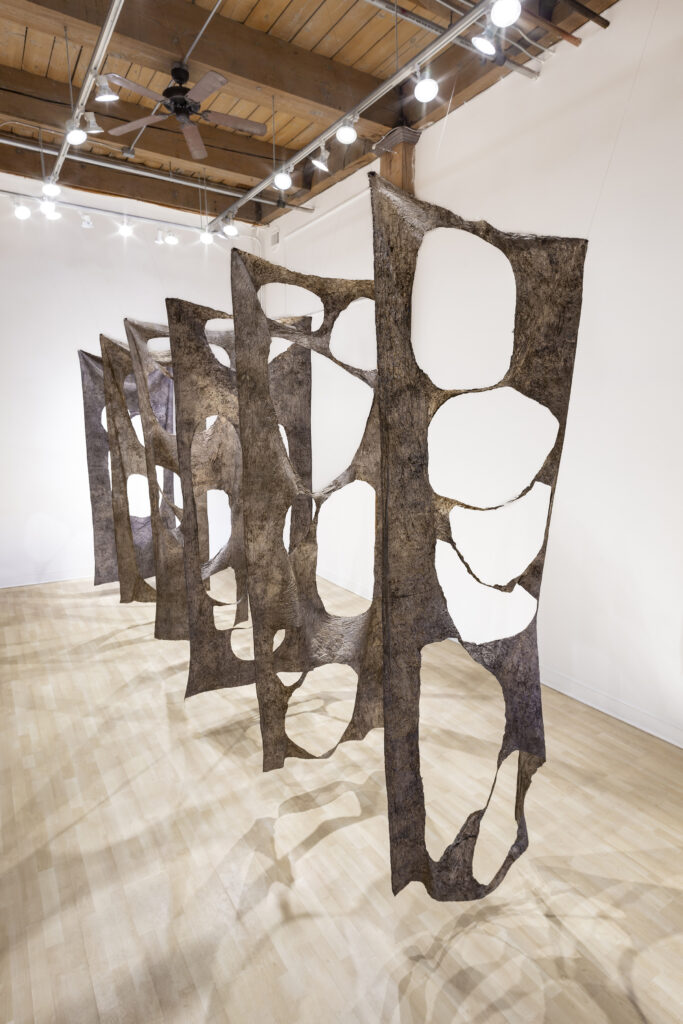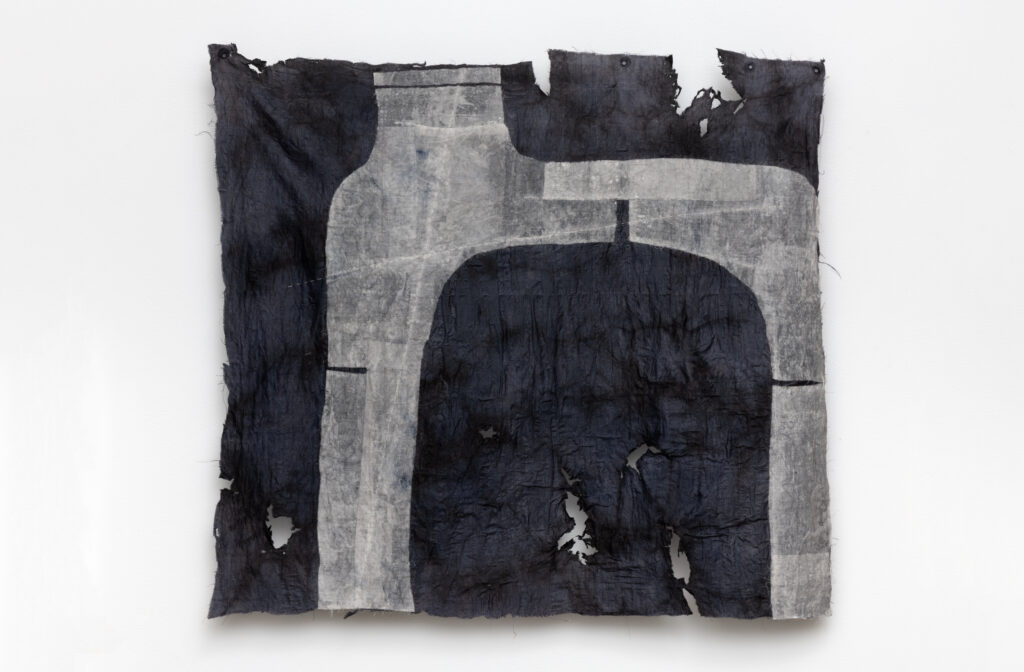You might catch a glimpse of her in between the shadows, wading hip deep in an undulating carpet of yellow peat hidden beneath the Minnesota pines. She bends low in the thick, murky waters as if baptizing the folds of fabric cradled in her arms.
“The Idea of letting go, letting the wild and nature take over is a common thread,” said Moira Bateman, the McKnight Fiber Art Fellow whose new body of work is a complete abandonment to nature. “I feel as if it’s freer work . . . Letting go of control and ALLOWING.”

Moira Bateman in her studio with her piece Watershed.
Bateman’s work is a study of metamorphoses. An environmentalist and student of famed sculptor Kinji Akagawa, she adopted the principle that all art is the product of gathering and creating ideas for the public to consume and reinterpret. Bateman applied this theory to the source of her artwork—the boggy mud and how the minerals in it enrich and transform pigments within the cloth. Fascinated by the natural dyes, Bateman flew to Seattle to learn more about mud dyeing with Aboubakar Fofana, an artist and master dyer from Mali known for his work revitalizing centuries-old dyeing techniques from West Africa. The ancient dyers believed working with raw materials revolved around the cycles of nature and themes of life, death, and the impermanence of change. Bateman said both Akagawa’s and Fofana’s theories made her artwork richer, while the control she was trying to let go of in her work actually added balance to it. “I feel my broad education in earth science alongside this design element helped me go in this direction,” said Bateman.
Her towering cloth panels play with the use of light and volume. Each piece of thin cloth is stitched and layered, becoming increasingly thicker with each layer, until the last layer is nearly opaque, the edges frayed and worn away by mud and dye. As shadows from the light move across the grouped cloth panels, Bateman said it forms “an interesting presence.” “It looks like a giant, human body with ribs rose right out of the bog.” Many of the torn, split, and flattened panels create lifelike forms due to the texture of the fabric.


Opening image and above: Bog Etude No.1; 2023; peace silk, thread, bog mud dye, bog mud, wax; mud dyed; 108 x 42 in. each of six panels. Photo credit courtesy of Peter Lee.
Bateman experimented with the tannins from bog leaves and added wax to the cloth, making the brown and black dyes translucent. It gives the fabric a “crispy” texture, almost like skin. Bateman trained birch branches to bend and caned them in a frame, holding the fabric together and becoming what could be described as a living vessel. It was cathartic for her. Every stitch and knot tied reminded Bateman of her mother, a prolific seamstress who passed away during the height of the pandemic. “It’s interesting how it formed just to those shapes,” she said. “It looked like a vessel for a human body, like I was sending someone off. It’s an homage to her.”
Somewhere off the Gunflint Trail, a bundle of cloth floats through the dark, still waters. Bateman hopes to find it on an upcoming trip north, curious about all the silt it’s absorbed during more than two years now. “I’m doing explorations with tannins and mud,” said Bateman. “There are lots of variables to try out.” As she talks her voice drifts off, already occupied with thoughts about wading in new waters, discovering new plants, and finding new clays to dig from the rich, dark bogs. For Bateman, it’s the thrill of creating the unknown. “I certainly invented where I was going . . . There’s something good about that.” moirabateman.com
***
Robyne Robinson is an Emmy-winning broadcaster and former art director at Minneapolis St. Paul Airport. The arts journalist is principal of five X five Public Art Consultants and lives in Santa Fe, New Mexico. fivexfiveart.com

Remainder; 2022; peace silk, thread, lake bottom mud stain, iron, wax; fabric left in lake bottom for one year, naturally dyed, stitched; 30 x 33 in. Photo credit courtesy of Rik Sferra.
Subscribe today and get our current issue FREE. Plus, get instant access to 20 original ebooks and 12+ years worth of digital magazines.

Over 120,000 fiber artists connect with Fiber Art Now through our various platforms – and we want you to join us! Connect and get inspired by contemporary fiber arts around the world.
For the latest news, special offers, and exclusive content you won’t find anywhere else, sign up for our newsletter below!